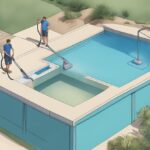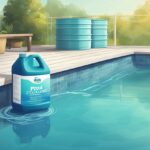Maintaining your pool is essential to ensure that it remains a clean and safe environment for swimming. A well-kept pool not only adds to the aesthetic appeal of your outdoor space but also prevents the growth of algae and the spread of harmful bacteria. By understanding the chemistry of your pool, you can effectively manage the water quality, balancing the pH levels, chlorine content and other chemical components for optimal conditions.

Routine pool maintenance involves a series of straightforward tasks such as cleaning, circulating and filtering the water. It’s important to regularly remove debris, inspect and clean the filter system, and check that the pump and skimmers are all functioning properly. This will keep the water clear and hygienic, reducing the need for corrective chemical treatments.
Alongside the mechanics of your pool, it’s also necessary to be mindful of the water’s chemistry. Monitoring levels such as chlorine, pH, and alkalinity is crucial for swimmer comfort and pool material integrity. Keeping track of these levels with frequent testing allows you to make precise adjustments, ensuring your pool water remains in pristine condition throughout the swimming season.
Understanding Pool Water Chemistry
Proper pool water chemistry is essential for maintaining a safe and inviting swimming environment. A well-balanced pool minimises the risk of bacterial growth, protects equipment from damage, and ensures swimmer comfort.
Balancing pH Levels
Balancing your pool’s pH is critical to maintaining water clarity and preventing corrosion or scaling of pool equipment. Your pool pH should ideally range between 7.2 and 7.8. High pH levels can lead to cloudy water and reduced chlorine efficiency. To lower pH levels, add pH reducer products that contain chemicals such as sodium bisulfate. If your pool has low pH levels, which can erode fixtures and cause swimmer discomfort, incrementally add a pH increaser like sodium carbonate.
- Ideal pH Level: 7.2 – 7.8
- To Lower pH: Add sodium bisulfate (pH Reducer)
- To Raise pH: Add sodium carbonate (pH Increaser)
Managing Chlorine and Bromine
Chlorine and bromine are the primary chemicals used to sanitise pool water, eliminating harmful pathogens. Maintain chlorine levels between 1 to 3 parts per million (ppm) and bromine levels, if used, between 3 to 5 ppm. High chlorine levels can lead to swimmer discomfort, so it is important not to surpass 3 ppm for chlorine. If you opt for bromine, ensure you never let the level drop below 3 ppm to effectively sanitise your pool.
- Chlorine Level: 1 – 3 ppm
- Bromine Level: 3 – 5 ppm
Regulating Alkalinity and Hardness
Together with pH, total alkalinity and calcium hardness are key facets of water balance. Maintain your pool’s total alkalinity between 80 to 120 ppm to stabilise pH levels. Calcium hardness, which determines how soft or hard your water is, should typically be between 200 and 400 ppm. High hardness can lead to calcium build-up.
- Total Alkalinity: 80 – 120 ppm
- Calcium Hardness: 200 – 400 ppm
Remember to test your pool water regularly and adjust these levels patiently, using appropriate chemicals, to keep your swimming pool in top condition.
Essential Pool Maintenance Equipment

Proper maintenance of your swimming pool requires a variety of equipment designed to keep the water healthy and clear. From effective filtration to debris removal, investing in the right tools is fundamental to your pool care routine.
Selecting the Right Pump and Filter
Your pool’s pump and filter system is the cornerstone of maintaining water clarity and hygiene. Pumps circulate water through the filter, which then removes impurities and debris. There are three main types of filters to consider:
- Sand filters trap dirt as water passes through sand.
- Cartridge filters use a pleated polyester filter to capture debris.
- The most effective but costly diatomaceous earth (DE) filters use a fine powder to filter microscopic debris.
It’s crucial to select a pump and filter with the appropriate capacity for your pool’s size.
Using Skimmers and Vacuums
The skimmers are essential for catching larger debris like leaves before they sink and decay. Ensure your skimmer basket is routinely emptied to maintain efficiency. For comprehensive cleaning, here are two varieties of vacuums to consider:
- Manual pool vacuums require you to move them around the pool, similar to vacuuming a carpet.
- Automatic pool cleaners, including robotic pool cleaners, roam around the pool on their own, saving you time and effort.
Ensure the pool vacuum you choose is suitable for your pool’s type and surface.
Additional Cleaning Tools
Beyond mechanised equipment, a set of manual tools will assist in maintaining your pool. Here’s a basic list:
- A pool brush for scrubbing walls and floors to prevent algae build-up.
- A net skimmer for daily removal of floating debris.
- Tennis balls can be used to absorb oils, such as sunscreens and natural oils shed by swimmers.
Regular use of these additional tools will keep your pool in top condition between more thorough cleaning sessions.
Routine Pool Cleaning and Maintenance
Proper pool care involves a combination of daily and weekly tasks, understanding the importance of good water circulation, and the ability to troubleshoot common issues. Following these steps ensures your swimming pool remains clean, safe, and enjoyable.
Daily and Weekly Tasks
Daily:
- Skimming: Remove leaves and other debris using a skimmer daily.
- Inspect: Check your pool’s water level to ensure it’s neither too high nor too low, as this can affect the pump functionality.
Weekly:
- Brushing: Brush the pool walls, floor, and steps to prevent algae buildup.
- Vacuuming: Vacuum the pool floor to eliminate dirt and debris.
- Chemical Testing: Test water pH levels, aiming for a range of 7.4 to 7.6 and chlorine levels between 1-3 ppm.
- Chemical Balancing: Adjust chemicals as required to maintain correct levels.
Maintaining Proper Circulation
Circulation:
- Essential for keeping the water clean and clear. Pools should have their water turned over at least once a day.
- Pump and Filter: Regularly check the pump and filter. Clean or replace filter cartridges as recommended by the manufacturer.
- Jets: Ensure the return jets are angled to facilitate water movement throughout the entire pool.
Troubleshooting Common Pool Problems
Algae Growth:
- Green Pool: Caused by stagnant water and insufficient chlorine.
- Treatment: Correct chemical imbalances, superchlorinate, and brush vigorously.
Contaminants:
- Phosphates: Act as nutrients for algae. Remove by using specific phosphate removers.
- Routine Maintenance: Regular upkeep such as refilling the pool, maintaining equipment, and replacing faulty parts prevents many common issues.











